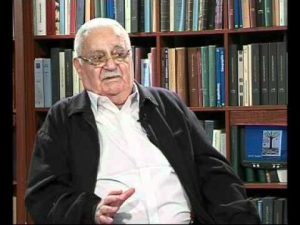
Yitzhak (Itzik) Livnat was born in 1930 in the name of Sandor Weiss, the fourth of five children, in the city of Velyki Sevljus in Czechoslovakia (now Vinogradov, Ukraine).
The family spoke Hungarian. Yitzhak’s mother, Terese (nee Lazerowicz), also spoke German and Yiddish, but Yitzhak and his brothers no longer spoke Yiddish and studied in a Hebrew school, since Yitzhak’s parents were Zionists. Later, in Auschwitz, the German Yitzhak knew from home helped him survive.
Yitzhak’s father, Wilmush, was the director of a farm that belonged to a Hungarian nobleman on the outskirts of the city. “Unlike most Hungarian or Czech Jews, we lived in the nature,” relates Yitzhak. In 1939 the city returned to Hungary and its name was changed to Nagyszőllős. At the height of the Second World War, Yitzhak’s older brother, Avraham (Bondi), was drafted into the Hungarian army’s labor battalions. Yitzhak’s mother died in January 1944.
In March 1944 the Germans occupied Hungary and in Nagyszőllős a ghetto was established. The farm owner tried to protect Yitzhak and his family, but in April the family was deported to the ghetto. At the end of May 1944, Yitzhak, his father, his two older sisters and his little sister Itsuka were deported to Auschwitz.
In the “selection”, Yitzhak was separated from his father and three sisters. The sisters were murdered in the gas chambers. Yitzhak was transferred to the children’s block and was the personal servant of the kapo in the block. At the end of September 1944, another selection was carried out. Yitzhak was included in a group of about 700 children who were destined for extermination and were imprisoned in the barracks. At night, one of the kapo’s assistants, whom Yitzhak had served, took Yitzhak out and transferred him to another block. There, Yitzhak met Chaim Rafael, a Jewish prisoner from Thessaloniki, Greece, who was six years his senior. Chaim knew only Ladino and Greek, but calmed Yitzhak for a long time, told him stories in broken German and taught him to sing.
In Birkenau, Yitzhak survived three Aktionen, by managing to escape from group to group, from barrack to barrack. In the fall of 1944, a number was tattooed on his hand. “The tattoo was a sign that they still need you for something,” said Yitzhak. “We really wanted to get these numbers, because if you do not have a number, then your future is not yet decided, whether you go to work or not go to work. My number is B-14694. It gave us a good feeling that now we are persons, we are no longer anonymous, we already have a number. Beforehand, we didn’t even have names – just a block of children – and that number was already mine. We were so happy about it – unbelievable that we finally got a number. “
On January 18, 1945, Yitzhak was sent on a death march from Birkenau. After about two weeks he arrived at the Mauthausen concentration camp in Austria, where he met his father. At the end of March 1945, the two were marched on another death march, feeding on grass and snails. They arrived at the Gonskirchen camp in Austria, lice-infested and sick with typhus. They were released by the American army and taken to a hospital in the village of Horshing near Linz. About two weeks after the liberation, the father died.
Yitzhak returned to his town to find out that their house was inhabited by strangers. He left in order to reach his brother Bondi in Palestine. He arrived in Budapest and from there he escaped with a group that had travelled from the Russian-occupied zone to the British area, reaching an orphanage in the Italian town of Selvino, where he was taught by emissaries from Palestine.
In March 1947, Yitzhak boarded the ship “Shabtai Luzhinsky.” The ship reached Nitzanim beach on Yitzhak’s 17th birthday. The immigrants got ashore but were caught by the British. Many Jews from the settlements in the area streamed to the beach and intervened among the immigrants to prevent the British from deporting the immigrants. In response, the British deported all those present on the beach to detention camps in Cyprus. Gradually, after an investigation, they released those they considered Israeli-Palestinian. Thanks to his good Hebrew, Yitzhak convinced the British that he was a veteran in the country and after a week he was “returned” to the Land of Israel.
Yitzhak joined the Haganah, participated in the War of Independence as a signaller, and later served as a signalling officer in the IDF.
Yitzhak Livnat was a member of the management of the Museum of the Heritage of Hungarian-Speaking Jewry in Safed. He was a “witness” and told his personal story to diverse audiences. He also documented it in the book “Outcasts – A Love Story.”
Yitzhak was a partner in the “Taavura” corporation and was one of the respected donors to our organization.
Yitzhak and Ilana have four children – all of whom are reserve officers in the Israel Defense Forces – twelve grandchildren, and great-grandchildren.
Yitzhak died in March 2017. His memory will be blessed!
You can listen to his testimony on Youtube
In 2013, a PhD track was opened at the University of Haifa, funded by Yitzhak’s family, which grants scholarships to students from all over the world. The goal is to promote Holocaust studies in Israel and around the world. The curriculum is multidisciplinary: study of Jewish and general history, sociology and even psychology. The program hosts lecturers from Haifa University and other universities in Israel and around the world, as well as specializations and collaborations with two governmental bodies: the Yad Vashem Museum and the Ghetto Fighters’ Museum.
In 2014, Yitzhak lit a torch during the Holocaust and Heroism Day ceremony that took place at Kibbutz Lohamei Hagetaot.